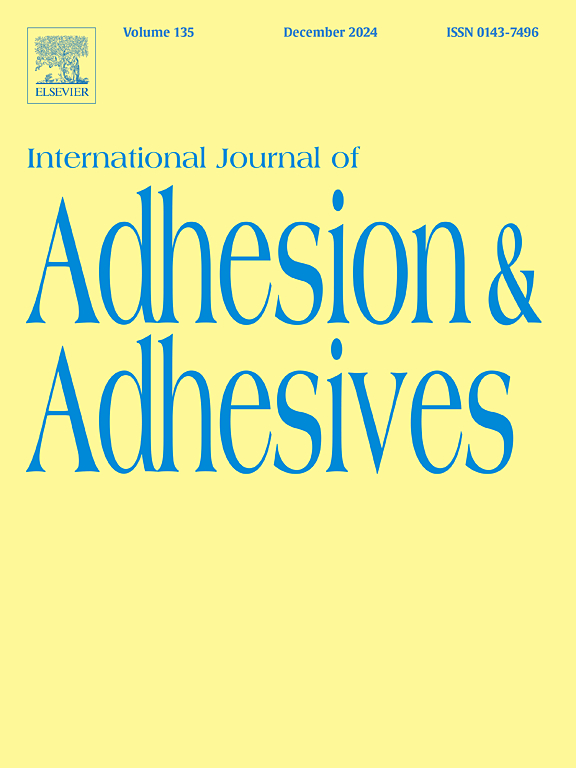Aging resistance and adhesion strength of cold plasma treated aluminum-polypropylene joints: The role of surface treatments and curing agents
IF 3.5
3区 材料科学
Q2 ENGINEERING, CHEMICAL
International Journal of Adhesion and Adhesives
Pub Date : 2025-04-07
DOI:10.1016/j.ijadhadh.2025.104027
引用次数: 0
Abstract
With the developing technology, Aluminum (Al) - Polypropylene (PP) composite materials, which combine lightness and high durability, are widely used especially in the aviation and automotive sectors. In this study, different combinations of surface treatment methods such as; sanding, sandblasting, chemical etching, anodization and cold vacuum plasma, were applied to the surface of PP and Al plates. After treatment procedures, these surfaces bonded with epoxy adhesives prepared with Triethylenetetramine (Teta), m-Xylenediamine (Mx) and Phenalkamine (PA) curing agents. The effect of the aging process on the bonding strength was investigated on various samples kept in a hot water bath for 2 months. Contact angle measurement, topography analyses, FTIR and tensile test measurements were conducted for evaluation of the given effects. In the experiments, the highest strength was obtained by bonding of sanded/plasma-treated PP plates with the chemical etched/anodized/plasma-treated Al plates. Compared to the non-surface treatment plates, an increase of 558.72 % was achieved and a tensile strength of 1840 N (9.2 MPa) was handled. According to the aging results, it was determined that the greatest decrease in adhesion strength occurred in the plates bonded with Teta, while the least decrease occurred with PA curing agent. More resistant structures to the aging were obtained by first sandblasted, then anodized and then plasma applied aluminum plates bonded with sanded and plasma activated PP surfaces. It was determined that especially plasma-treated surfaces were more resistant to the aging than non-plasma activated surfaces.
冷等离子体处理铝-聚丙烯接头的抗老化性能和粘接强度:表面处理和固化剂的作用
随着技术的发展,铝(Al) -聚丙烯(PP)复合材料以其轻量化和高耐用性得到了广泛的应用,特别是在航空和汽车领域。在本研究中,不同组合的表面处理方法如;采用喷砂、喷砂、化学蚀刻、阳极氧化和冷真空等离子体等方法对PP板和Al板进行表面处理。经过处理后,这些表面与由三乙基四胺(Teta)、间二甲二胺(Mx)和苯萘胺(PA)固化剂制备的环氧粘合剂粘合。在热水浴中放置2个月,研究了时效过程对粘接强度的影响。通过接触角测量、形貌分析、FTIR和拉伸试验测量来评估给定的效果。在实验中,砂光/等离子体处理的PP板与化学蚀刻/阳极氧化/等离子体处理的Al板结合得到了最高的强度。与未经表面处理的板材相比,提高了558.72%,抗拉强度达到了1840 N (9.2 MPa)。根据老化结果,确定与Teta结合的板的粘接强度下降最大,而与PA固化剂结合的板的粘接强度下降最小。采用喷砂、阳极氧化、等离子体处理铝板,结合喷砂和等离子体活化的PP表面,得到了更耐老化的结构。结果表明,等离子体处理的表面比非等离子体活化的表面更耐老化。
本文章由计算机程序翻译,如有差异,请以英文原文为准。
求助全文
约1分钟内获得全文
求助全文
来源期刊

International Journal of Adhesion and Adhesives
工程技术-材料科学:综合
CiteScore
6.90
自引率
8.80%
发文量
200
审稿时长
8.3 months
期刊介绍:
The International Journal of Adhesion and Adhesives draws together the many aspects of the science and technology of adhesive materials, from fundamental research and development work to industrial applications. Subject areas covered include: interfacial interactions, surface chemistry, methods of testing, accumulation of test data on physical and mechanical properties, environmental effects, new adhesive materials, sealants, design of bonded joints, and manufacturing technology.
 求助内容:
求助内容: 应助结果提醒方式:
应助结果提醒方式:


